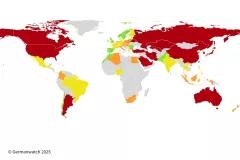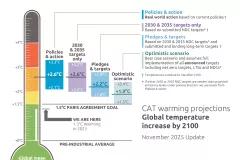Press release Climate Action Tracker: China’s climate targets for Paris are conflicted
China’s new climate plans announced this week for the Paris Climate Agreement are conflicted, the Climate Action Tracker (CAT) said today.
See the full assessment of China's INDC
China’s non-fossil primary energy target, actions to reduce coal use and wide range of other actions are set to make a major step toward a below 2oC pathway. However, one element – the proposed carbon intensity target - is much weaker than all the other elements put together and would be consistent with a warming of 3-4oC.
This has led the CAT to give China’s plans a unique dual rating of both “Medium” for its national policies and actions, which are more ambitious than new carbon intensity target, and “Inadequate” for its 2030 carbon intensity target.

Climate Action Tracker Analysis for China's INDC
China submitted its INDC (Intended Nationally Determined Contribution) to the UN, ahead of the Paris climate talks in November. It includes a target to peak CO2 emissions by 2030 or earlier, to increase non-fossil share of its primary energy to around 20% by 2030, and to reduce the economy’s carbon intensity by 60-65% by 2030, compared to 2005 levels. It proposes action on non-CO2 greenhouse gas emissions, including on HFC23 a super greenhouse gas and it further anticipates an increase in forest stocks. The INDC also lists comprehensive actions to achieve the targets, of which many are already being implemented.
The CAT analysis shows that China’s CO2 emissions from energy and industry could peak between 2025 and 2030 – as a result of policies in place and the proposed 20% non-fossil target by 2030. Total emissions are likely to continue to increase, reaching about 13.6 GtCO2e in 2030. The CAT has rated this as “medium” – meaning that China is not on a pathway that would hold warming below 2˚C unless other countries implement much more ambitious action.
However there is a conflict between most of the INDC elements and national actions - and the proposed 2030 carbon intensity target. If this weak target is taken in isolation from all other aspects of the INDC, it would result in much higher emission levels in 2030 (at 15-16.9 GtCO2e), and require a substantial reversal of present declining trends in coal use and lead to increased air pollution. The CAT judges this to be unlikely.
The CAT rates the weak carbon intensity target of China’s INDC as “Inadequate,” a category that, if all governments were to make comparable efforts, would see warming exceed 3-4˚C of warming. If China were to improve its carbon intensity target to 70% by 2030 from 2005 levels, it would rate as “Medium.”
“The difference between China’s carbon intensity goal and its national actions and goals is disappointing. It may reflect a desire by the Chinese Government to have a “safe” international goal,” said Hanna Fekete of NewClimate Institute.
“China’s national actions and policies are already set to drive a large decarbonisation of its economy: it looks set to surpass its 2020 target, and could meet its 2030 target five years earlier,” said Bill Hare of Climate Analytics.
“To avoid a lock-in of warming over 2oC, China needs to give serious consideration to setting targets for 2025, rather than 2030, so that the Paris Agreement can improve quickly.”
“There is plenty of room for the world’s biggest emitter to step up, remove its safety net, and bring emissions closer to a 2˚C pathway, which would be an extremely important move ahead of Paris.”
The CAT analysis also shows that while CO2 emissions may peak between 2025-30, non-CO2 greenhouse gas emissions - such as nitrous oxide from industry, methane from agriculture and waste, and some HFCs - are projected to continue increasing until 2030. The INDC propose action in each of these areas for the first time, with likely reductions in HFC23, but insufficient information is available to fully quantify reductions.
“While non-CO2 emissions will continue to rise through to 2030 under current policies, it is good news that China has targeted reductions of both HFCs and HCFCs – an important stepping stone towards tackling these emissions,” said Prof Kornelis Blok of Ecofys.
Read the full analysis here.






